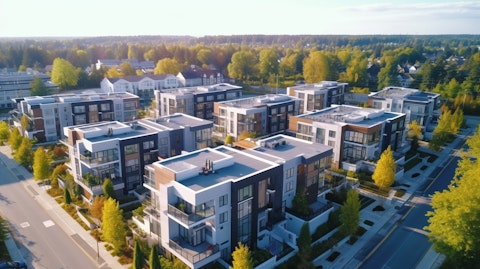KE Holdings Inc. (NYSE:BEKE) Q3 2023 Earnings Call Transcript November 8, 2023
KE Holdings Inc. beats earnings expectations. Reported EPS is $1.81, expectations were $0.11.
Operator: Ladies and gentlemen, thank you for standing by for KE Holdings Inc.’s Third Quarter 2023 Earnings Conference Call. Please note that today’s call, including management’s prepared remarks and question-and-answer session, will all be in English. Simultaneous interpretation of Chinese is available on a separate line for the duration of the call. To access the call in Chinese, you will need to dial into the Chinese language line. At this time, all participants are in a listen-only mode. Today’s conference is being recorded. I would now like to hand the call over to your host, Ms. Siting Li, IR Director of the company. Please go ahead, Siting.
Siting Li: Thank you, operator. Good evening, and good morning, everyone. Welcome to KE Holdings or Beike’s third quarter 2023 earnings conference call. The company’s financial and operating results were published in the press release earlier today and are posted on the company’s IR website, investors.ke.com. On today’s call, we have Mr. Stanley Peng, our Co-Founder, Chairman and Chief Executive Officer; and Mr. Tao Xu, our Executive Director and Chief Financial Officer. Mr. Peng will provide an overview of our strategies and business development, and Mr. Xu will provide additional details on the company’s financial results. Before we continue, I refer you to our safe harbor statements in our earnings press release, which apply to this call as we will make forward-looking statements.
Please also note that Beike’s earnings press release and this conference call include discussions of unaudited GAAP financial information, as well as unaudited non-GAAP financial measures. Please refer to the company’s press release, which contains a reconciliation of the unaudited non-GAAP measures to comparable GAAP measures. Lastly, unless otherwise stated, all figures mentioned during this conference call are in RMB. For today’s call, the management will use English as the main language. Please note that the Chinese translation is for convenience purposes only. In the case of any discrepancy, management statements in the original language will prevail. With that, I will now turn the call over to our Chairman and CEO, Mr. Stanley Peng.
Please go ahead, Stanley.
Stanley Peng: Thank you, Siting. Hello, everyone. Thank you for joining Beike’s third quarter of 2023 earnings conference call. In the third quarter, the real estate market showed a notable rebound following the strong setting of the Politburo meeting and a series of supportive politics, including modification to first-time homebuyers’ qualifications in first-tier cities. The degree of support and the implementation of these favorable measures, as well as the real estate market’s performance, both went beyond our expectations. Our focus this year has been on contemplating the future over the long term and aligning our strategy with it. We are entering a new phase that we call crossing the next mountain. This phase begins as the market continues its shift from same-property purchases and investment in assets to prioritizing residential housing for the quality of living itself.
In this transaction, we must also evolve from a transaction-centric operating model to one that is dedicated to ensure better living experiences for our customers. This is a largely untapped market with vast opportunities. Real estate’s the return to a focus on people’s better living signals are promising future ahead of us. With industry experience and insight, we have cultivated over the years. We are well positioned to grow in a new phase compassing many possibilities of better living. Beike has established the industry’s most powerful infrastructure, our ACN, throughout our existing home transaction business. This infrastructure, integrating our online databases and traffic networkers with offline stores and engineer works, lays a solid base for us to explore new possibilities.
Additionally, our management expertise for large groups in our digital capabilities and data-driven strategies collectively support our journey into this exciting future. This July, we took an important step toward our objectives by upgrading our corporate strategy to One Body, Three Wings. This is a key step in our roadmap to becoming the well-installed residential service platform for better living. As we navigate the dynamic landscape, we need a deeper, differentiated mindset, a knowledge base, as well as a set of mutual principles and guidelines to identify core value propositions to drive us forward in the right direction. To that end, there are a host of key questions we are asking ourselves. What the value can technology bring to both customers and service providers?
Our business segments are separated, but the customers are asking for a one-stop solution. In what ways can we unite our vertical business segment to create horizontal one-stop services that meet customers’ needs? How can we maximize customers’ living endurance and extend beyond merely delivering transactional value? What’s our value proposition to different stakeholders in our industry, including our partners and service providers? How do we focus on offerings true value and humanistic care for our service providers rather than treating people as tools and channels? In addressing the broader residential industry, do we look for growth through physical expansion or through generating chemical reactions to drive industry-wide evolution?
The next step to posing these questions is calling on everyone in our organization to think about them and working together to address these topics. While engaging in these crucial reflections to direct our strategy, we are also implementing organizational modifications and business initiatives of our One Body, Three Wings strategy, which will be reflected in our performance metrics. With the easing of COVID restrictions, pent-up demand dropped the market’s recovery in the first quarter of this year. However, subsequent home transaction market activities deviated from historical seasonal trends. New home market is still facing some challenges. In the third quarter, we recorded a GTV of RMB655.2 billion. There was a 2% and 27% year-over-year decrease in existing home transactions and new home transactions, respectively.
And our overall performance has exceeded the expectations. Our revenue for the quarter was RMB17.8 billion, up by 1.2% year-over-year. Year-to-date, GTV has grown by 23%, with existing home transactions up 28%, new home transactions up by 13%. In our efforts to manage risk and improve efficiency over the past two years, our One Body operations, which is our home transaction services, are more agile and efficient. It’s now time to broaden our collaboration with more industry partners and service providers as we advance together to offering one-stop residential services for better living. Here, we will further institute standardization for people, objects, and services to promote the industry advancements over the next decades. Starting in the third quarter, we accelerated our store network expansions.
In September alone, we added around 1,300 newly connected stores nationwide, excluding Beijing and Shanghai. In the third quarter, contracted sales from our home renovation and furnishing business reached RMB3.26 billion, an increase of 66% year-over-year. Year-to-date, contracted sales reached RMB9.39 billion, up 19% year-over-year on our pro forma basis. Additionally, contracted rental units of our rental property management services grew from 50,000 in the third quarter of 2022 to 160,000 in the third quarter of this year. Many of the metrics that I mentioned are derived from our emerging businesses. More importantly, the long-term driver behind our business development is a consistently enhanced understanding of the industry landscape. Rapid growth and scalable operations have provided us with a deeper understanding of the industry and the capabilities to execute on small-scale testing approaches to make rapid business interaction across our service ecosystem.
The build-up of SaaS systems systematic capabilities means knowing which metrics to use and how many parameters we should set in the business. Rather than how high the parameter is set, the deep dive and scale of our One Body business have accelerated our scientific management and competitiveness. It’s the equivalent of taking 50 steps forward. However, with our emerging business, we have only just taken out first step. It’s crucial to note that while growth and building scale are best growth, they are not the sole objectives. We also deeply understand the importance of supporting the industry ecosystem. Platform-wise, while we have notably improved our efficiency and our operational capabilities over the last two years, we need to be careful about path dependence, building and maintaining synergistic relationships with all of our partners, whether they are brands, store owners, or developers, is of great importance to us.
We will make adjustments to our operational strategy to better improve store owners’ endurance and engagement, refining our platform capabilities to empower them and establishing store owners committees that ensure collaborative developments and dominance. We started Lianjia and Beike driven wide by wheel to make the industry better and today we need to adhere to underlying with understanding value auto tool becoming an interpreter in advanced productivity. It’s essential to bring unique value to the industry. We are not competing against existing service providers, or business partners in the industry, but ran rather against low quality supply that damage the industry reputation and diminishes customary ignorance. This is why we need to work hard to push for an overall improvement in the quality of the industry.
Given our recent progress and the growing consumer demand for service and quality, we are seeing tremendous promise. We also believe that one day we will proudly advocate for this industry. Thank you. Next I would like to turn the call over to our CFO, Xu Tao to review our third quarter financials.
Tao Xu: Well thank you, Stanley. And thank you everyone for joining us. Before we dive into our performance, I would like to briefly touch upon some updates on recent housing markets. The third quarter saw the property market pick up from the bottom with month-over-month sequential recovery. Important policy directives were made during the Politburo meeting in late July addressing new clients in real estate supply and the demand. Since the end of August, a wave of supportive policies has been rolled out with many cities take steps to modified the criteria of first time home buyer qualifications, lower down payment ratios cut market interest rates and relaxed purchase restrictions. Market sentiment notably improved with transaction substantially rebounding since September.

This recovery was particularly pronounced for the existing housing market in first year and some strong secondary phases. To our expectations policy relaxations and the demand for housing upgrades are the most substantial. The recovery of new home market lack slightly behind the existing home due to the varying demand across cities and volatilities on developer supply side. Nevertheless, since August there has been some improvement in the new home markets, but new home subscription data on platform showed both year-over-year and a month-over-month recovery in September. We have been proactively advancing our ‘One Body, Three Wings’ growth strategy. In terms of our overall financial performance in Q3 we maintained vigilant and top line performance with total revenue growing 1.2% year-on-year, reaching RMB17.8 billion, exceeding our guidance along which surpassing especially the revenue for housing transactions and services.
We also made a remarkable breakthroughs for our home renovation and furnishing business, with revenue [indiscernible] jumping 72.1% year-over-year to RMB3.2 billion. Notably our enhanced operational capability coupled with our careful cost discipline developed in previous years generated a gross margin of 27.4% for Q3. Kicking off by 0.4%-ish points from the same period last year. With overall revenue at level relatively consistent with the same period last year, our GAAP net income saw a 63.4% year-over-year increase, reaching RMB1,170 million, while non-GAAP net income grew by 14.4% to RMB2,159 million. Non-GAAP net margin rose by 1.4 percentage points year-over-year to reach 12.1%, showcasing stronger profitability. Looking at our home transaction services, in Q3 on national level both existing and new home markets declined quarter-over-quarter and year-over-year due to notable quarterly disparity in market dynamics compared to previous years.
However, benefitted from our enhanced operational efficiency our GTV of existing homes only filled by 2.2% year-over-year, despite the higher base set by four states in the same period last year. Revenue from existing transaction services declined by 11.9% year-over-year to RMB6.3 billion. The bigger contraction of existing home revenue compared to that of GTV was primarily due to a lower contribution from the GTV served by Lianjia brands, which has high material utilization rate. Lianjia GTV grew by 13% year-on-year on a higher base set by first tier cities in the same period last year. While exiting home GTV served by connected agents increased by 8.1% year-over-year in Q3. And the revenue of which is recorded on net basis resolving the gap between the gross rate of our revenue and GTV.
Meanwhile, on September 26, Beijing Lianjia [indiscernible] commission rate which suppliers and sellers each paying 1% of the property total transaction volume for about 12,000 ongoing transaction initiated before the adjustment came into effect, while refunding the differences resulting from the rate adjustment. Adhering to our principle for putting customer first, the corresponding impact has already been reflected in our Q3 extinct home revenues. We firmly believe that by sincerely serving our customers best interest, we can earn long-term trust as they bring us lasting growth opportunities. Contribution margin for existing home transaction services was at 48.7%, reflecting a year-over-year increase of 2.6 percentage points and a quarter-over-quarter increase of 3.1 percentage points.
This is indicative of how our core streamlined cost structure has enabled us to achieve stronger profitability instead of year-on-year decline in revenue. Let’s move to our new home business. The industry is ongoing a phase of reduced supply and continued risk mitigation evidenced by a more than 30% year-over-year decline in sales from the top 100 developers in Q3. We have adopt an active strategy of expanding channel collaboration with developers and continued to improve our business ecosystem, while strictly adhering to our risk control bottom lines. As a result, our new home GTV decreased by 26.5% year-over-year, outperforming the overall market. The decline of 24.3% in new home revenue was smaller compared to GTV owing to a slight increase in our monetization rate.
Our new home business contribution margin grew slightly year-over-year to 25.1% despite decline in revenue, fully demonstrating our operational resilience. In Q3, the percentage of commission income from SOE developers remained at 46%. Project with Commission in Advance model contribute 54% of total commissions collected remaining at a high level. Regarding our emerging business, the revenue from our business excluding home transaction services grew by 112% year-over-year, with its percentage to total revenues rising to over 30% in Q3, compared with 15% in the same period last year. Our home renovation and furniture business has remained on a fast track with a robust growth momentum that was not resilient on the trend of housing transaction services.
Contracted sales reached RMB3.3 billion in Q3, a year-over-year increase of 65.6% with fast delivery and accelerated revenue recognition. Revenue grew at a higher rate of 72.1% year-over-year, reaching RMB3.2 billion, a quarter-over-quarter increase of 21%. In Q3, Shanghai reported the two months with revenue exceeding RMB 100million, becoming the third city following Beijing and Hangzhou to achieve monthly revenue surpassing RMB100 million. Other cities are also growing rapidly. Cities including Wuhan, Chengdu and Guangzhou achieving a quarter-over-quarter revenue growth of over 50% in Q3. Our customer acquisition capability continued to improve with both Beijing and Shanghai achieving business leads conversion rate in the middle to high single digit percentage.
The percentage of contract sales contributed by our home transaction services continued to increase to about 45% of total GTV. The sales of decoration home furniture increased by 93% to RMB920 million, with a proportion of 28%. The contribution margin for home renovation and furnishing business in Q3 remains at 29.1%. A further solidified foundation in product design and SKU assembly is developing a positive cycle of our profitability across the leading cities. Ten cities including Beijing, Shanghai and Hangzhou realized the positive city level profit in Q2 and Q3 consecutively. Among the top 10 cities in terms of the contract sales, seven of them have positive operating profits. The breakthroughs we have made have given us greater confidence in our strategy.
In October, we announced the proposed acquisition of Kongjian and the deal is subject to the customary closing conditions. This will strive to bring higher quality offering to the residential industry. In Q3 our net revenue from emerging and other services increased by 202.7% year-over-year to RMB2.4 billion, primarily proposed by the expansion of our rental property management services, Contribution margin remains stable at 25.3% year-over-year. The total of our store cost and other costs remain stable in Q3. Our gross profit grew by 2.6% year-over-year reaching RMB4.9 billion as a result of our increased operating leverage. Our gross margin ticket up to 27.4% compared with 27% in the same period last year. In terms of expense year-over-year, our GAAP operating expenses for Q3 totaled RMB4 billion, increasing 12% from the same period last year.
Our non-GAAP operating expenses amounted to RMB3.1 billion, up 14% year-over-year, primarily due to the structural impact of the increased proportion from new business including home renovation and furniture. Looking at quarter-over-quarter performance, we have maintained effective cost control in our home construction services notably with the RMB32 million better provisions written back during Q3, providing us with improved operational leverage. In terms of the profitability, on the GAAP measures, our income from operations for Q3 was RMB911 million, compared with RMB1.2 billion in the same period last year. Our operating margin was at 5.1%, compared with 6.9% in the same period last year. Our non-GAAP income from operations was RMB1,886 million compared with RMB2,108 million in the same period last year.
Non-GAAP operating margin was 10.6% compared with 12% same period last year. The dip was mainly due to our investment in new business including home renovation and furniture, which was in ramp up period. Our GAAP net income for the quarter reached RMB1,170 million reflecting a significant growth of 63.4% year-over-year. Our non-GAAP net income increased by 14.4% year-over-year reaching RMB2,159 million. Non-GAAP net margin rose by 1.4 percentage points year-over-year to reach 12.1%. Now let me highlight our cash flow and the balance sheet metrics. Excluding customer deposit payable, we realize the net operating cash inflow of RMB2,658 million in Q3. The new home cash collection surpassed the new home revenue for ninth consecutive quarter with a cash to income ratio for the rising to 1.21.
New home DSO for the first three quarters was the 52 days. In Q3, we spent approximately US$162 million in share repurchase and around US$200 million in special cash dividends. On top of that, our total cash liquidity, which includes customer deposit payable amounted to RMB79.8 billion, up RMB440 million from Q2. Over the recent period, supported by our solid cash reserves and prudent financial management will demonstrate our commitment to efficient capital allocation and delivering returns to our investors through the active share buybacks and the dividend repatriation. This September alone, our total stock repurchase amount over US$130 million. Since the initiation of our share repurchase program in September 2022, as of September this year, the total number of shares that we have cumulatively repurchased amounted about 3.91% of companies total share prior to launch our program.
Moreover, recently we have completed a special cash dividend distribution totaling around US$200 million. Looking at our guidance for the fourth quarter. We expect the total revenue to be between RMB18 billion and RMB18.5 billion, representing an increase of approximately 7.5% to 10.5% from the same period of 2022. This forecast includes the potential impact of the real estate related policies and the macroeconomic status that constitutes the current and preliminary view of our business and the market conditions, which are subject to change. The property market transformation and upgrade towards living and the strengths of our organization structure have all bolstered our aspiration and momentum for continuous growth. Our focus remains on expanding connections with top tier industry capability and fostering a cooperative ecosystem of the furnace and the win-win scenarios.
We are simultaneously developing a high quality service provider talent pool and formally dedicating resources in infrastructure development. As we thrive in the vast residential sector, we are positioned to expand into the significant opportunity that lie ahead. Our ability to effective balance scale, efficiency and financial stability has been force validated during the market fluctuations over past few years. Under this volatility, we also achieved the consistent improvement in business growth, profitability, and cash flow. Looking forward, we will maintain our disciplined approach to financial management, further enhance our capital allocation efficiency. We will prioritize our investment in business areas that can bring key outputs and values, investing in growth, investing in future.
We will also share the benefit of the developments with our shareholders. We believe this will enable us to achieve organic and substantial growth, creating long-term value for our shareholders. This concludes our prepared remarks. Now we are open for the questions. Operator, please go ahead.
See also 13 Best Real Estate and Realty Stocks To Buy According To Hedge Funds and 12 Safe Stocks To Invest In For The Long-Term in 2023.
Q&A Session
Follow Ke Holdings Inc. (NYSE:BEKE)
Follow Ke Holdings Inc. (NYSE:BEKE)
Operator: Thank you. [Operator Instructions] Your first question comes from Timothy Zhao with Goldman Sachs. Please go ahead.
Timothy Zhao: [Foreign Language] Thank you, management for taking my question, and congrats on the very strong results. Just one question [indiscernible] provide us an overview of the housing transaction market in the past quarter and what is our outlook for the fourth quarter this year and after the mortgage easing policy announced in the third quarter, what is measurement observation in terms of the policy impact on home transactions? Thank you.
Stanley Peng: Thank you, Timothy. Regarding your question, we notice that the investors pay close attention to the market change in property market. I can share some of our perspectives. In terms of the policy, there has been relaxation or even removal of the restrictions on housing transaction in certain second tier cities since the July Politburo Meeting. From the end of August to early September, first tier cities have implemented policies to recognize households with mortgage record but no local property ownership as first time home buyers. Additionally, Guangzhou, being the first among Tier 1 cities has eased its home purchase restriction in September. Moreover, mortgage rate for both first and second time home in top 100 cities decreased by 25 and 34 basis points respectively year-over-year.
In third quarter, the existing home market improved from its June performance, driven by the anticipation of supported policies to come and subsequent policy release. To elaborate this, the number of existing home transactions grow by single digits month-over-month in both July and August. This update shows that things are stabilizing and recovering due to the expectation for new policies. After relax, first time home buyer qualification policy was implemented in September, our platform saw an operate surge in existing home sales with growth rate of 25% compared to previous month and 32% compared to last year. In particular, for the first tier cities, the recovery actually starts quite early and they also rebounded the most in September. After Politburo Meeting at the end of July, this city has already seen certain market recovery expectations.
The number of the home showing and the listing increased by 5% to 10% from July to August, while transaction volume in September grow by over 30% month-over-month. Stronger second tier cities like Nanjing, Hefei, Wuhan, and Hangzhou relaxed their home buying restrictions in September led to a stronger recovery in transaction volume of 25% growth month-over-month. This also demonstrates the effectiveness of the policy measures. For home prices, according to data from Baker Research Institute, Beijing and Shanghai start to stabilize in July and in September, they even increased by 1.6% and 1.9%, respectively compared to July. While many other cities across the country still saw a decrease in their home prices, the rate of decline has slowed down in September.
The new home market in the third quarter of 2023 has also shown signs of rebound following the resurgence in existing home market, a notable disparity was seen in both supply and demand side. Subscriptions for new homes experience a modest double-digit month-over-month recovery in August. However, in September, the new home subscription volume on the Beike platform increased by more than 40% month-over-month and 15% year-over-year. This is a significant divergence from the historical month-over-month decline. In September, over the last three years, indicating that this September’s rebound was largely driven by partial support and improved market sentiment rather than seasonality. Transaction date typically lags behind subscription data by about three weeks.
Accordingly, more positive change in transaction data is expected in October. A closer look indicates that the new home market displays a high degree of disparity. In September, one year-over-year growth rate for new home subscriptions was through the roof in first tier cities by the 49%, pretty solid in stronger second tier cities at 20%, but negative 18% for other low tier cities. The demand for home upgrades is higher in first tier cities. The first time home buyer qualification policy help pump more liquidity into this respective new home market and gave a big boost to those top tier cities like Guangzhou, Nanjing and Changshan that have stronger fundamentals. But when they eased up on purchase restrictions in these leading cities, it also caused taking away some of demand from neighboring low tier cities.
As new home sales market being heavily influenced by the supply side, at least two significant fluctuations in high frequency data whilst its in home market shows more consistency, making it a better indicator for overall market activities. Looking ahead, the policy effect of new policies will continue to unfold. The date of exiting home transaction in October has been pretty consistent on a weekly basis with a gradual increase. Nevertheless, it is important to remember that it takes time for policies to be kicked in and for demands to turn into actual sales yearly spanning several months. The uncertainty in new home price trends will make potential buyer cautious and adult wait and see attitude. To keep up with and stimulate home buying and upgrading activities and attract more buyers to the market, we need further policy support, stable housing price and property doesn’t match the changing needs of consumer for better living conditions.
Additionally, easing in purchase restriction in different cities along with the revised qualification for first time home buyers are expected to boost reasonable demand for first homes and further activate transactions in the market. Thank you.
Operator: Thank you. Your next question comes from John Lam with UBS. Please go ahead.
John Lam: [Foreign Language] So thank you for taking my questions and also congrats for the great result. And the question is more regarding the new home business. So how do we see the property developers for their sales strategy in the upcoming fourth quarter strong season? And also how do they think about the cooperation with the channel. Regarding on the recent relaxation of the price gap for both property price and also land price? Would that mean that this is positive to your new home business? Regarding on the operation, Beike has been the industry leader for the new home business. So any area for further improvement that could share to investor. Thank you.
Tao Xu: Thank you, John. The current new home market is complex and consistently changing, which poses significant challenges for everyone involved in the industry. Although, new home generally offer better design and quality compared with existing ones. In cities, where there are risks associated with delivery pursued home on time. Consumers tend to lean towards buying existing homes. In key cities, the percentage of consumers interested in purchasing new home has dropped from 33% in 2021 to 70% in September. In one of our core central status, the proportion of a transaction in these new homes has rising from 25% in September 2021 to 70% this year. In cities, like Chengdu, where timely delivery of appraisal hold is insured more effectively.





